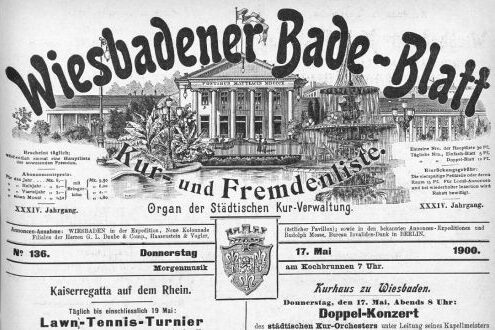Spa and tourist list
The spa and visitors' list recorded all spa guests arriving and departing in Wiesbaden over many eras, as well as their accommodation, and thus offers a lively insight into the city's former spa life.
The "Kur- und Fremdenliste" is probably the most productive source for prosopographical studies of Wiesbaden's bathing activities in modern times.
It first appeared in the "Hoch-Fürstlich Nassau-Saarbrück-Usingischen privilegirten gemeinnützigen Wiesbader Nachrichten und Anzeigen" (later: Wiesbade[ne]r Wochenblatt), the first surviving volume of which dates back to 1774. From the very beginning, the "Kur- und Fremdenliste" (spa and visitors' list) indicated the day of arrival/departure and the accommodation of each individual spa guest in the town. It was arranged alphabetically according to bathhouses; the Jewish bathhouses were initially listed separately, but in 1810 they were also integrated into the alphabet.
From 1810, the spa list was edited by the government official who was also responsible for the "Verordnungs- und Intelligenzblatt". The stronger state control during the Restoration period is also evident in the practice from 1816 of including private houses as places of residence for visitors: Spa owners as well as innkeepers were obliged to keep "Fremdenbüchern" (visitors' books); registration slips listing arrivals and departures had to be handed in to the police every Saturday. Until 1852, a distinction was also made between spa guests and "transients"; both groups were counted annually with consecutive numbers.
As the spa and bathing business flourished from around 1840, the list became a lucrative investment for the respective printer due to its growing advertising section. When the "Wochenblatt" was replaced by the new Wiesbadener Tagblatt in 1852, the printer Karl August Emil Schellenberg took over the Kurliste as an independent organ for a few years.
A change occurred in 1867, when the printing and publishing of the list was taken over by the Kurverein (Kur- und Verkehrsverein e.V.), which had been founded shortly beforehand under Ferdinand Hey'l. The "Wiesbadener Badeblatt", now published for the first time, offered not only the previous spa list, but also those of neighboring resorts, as well as a feuilleton section and a calendar of events. This opulent layout remained in place even when the municipal spa administration took over publication in 1898 and the spa business reached its peak in the years before the outbreak of the First World War (an average of 200,000 guests per year before 1914).
The "Wiesbadener Badeblatt" was discontinued at the end of 1933; from 1936 to 1941, a successor magazine was published, the "Wiesbadener Kurgast", which also contained the spa list again. An attempt at revival from 1951 to 1957 ("Kur- und Fremdenblatt") saw itself more as a feuilletonistic accompaniment to a spa stay and dispensed with visitor lists from the outset.
Most of the volumes of the Kur- und Fremdenliste are preserved in the RheinMain University and State Library, while a smaller collection also exists in the archive of the Schellenberg'sche Hofbuchdruckerei. Unfortunately, a few volumes, especially from the early period, can no longer be traced. The full texts are available under "Wiesbadener Badeblatt digital" (volumes 1867-1933) on the website of the RheinMain University and State Library.
Literature
The Wiesbaden spa list. In: Mitteilungen des Vereins für Nassauische Altertumskunde und Geschichtsforschung 1900/1901, issue 3 (pp. 74-87).
